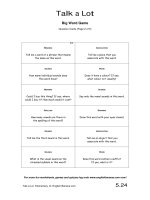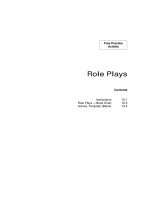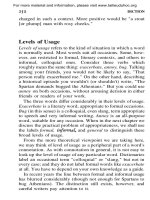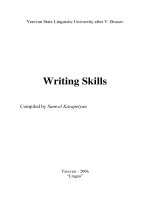Tài liệu Developing writting skills 1 part 10 docx
Bạn đang xem bản rút gọn của tài liệu. Xem và tải ngay bản đầy đủ của tài liệu tại đây (731.71 KB, 13 trang )
e.g. In his famous and influential work
On the
Interpretation of Dreams, Sigmund Freud argues that
dreams are the "royal road to the unconscious"
(page), expressing in coded imagery the dreamer's
unfulfilled wishes through a process known as the
"dream work" (page). According to Freud, actual but
unacceptable desires are censored internally and
subjected to coding through layers of condensation
and displacement before emerging in a kind of rebus
puzzle in the dream itself (pages).
How to use quotations, paraphrases, and summaries? Practice
summarizing the following essay, using paraphrases and quotations
as you go. It might be helpful to follow these steps:
• Read the entire text, noting the key points and main ideas.
• Summarize in your own words what the single main idea of
the essay is.
• Paraphrase important supporting points that come up in the
essay.
• Consider any words, phrases, or brief passages that you
believe should be quoted directly.
There are several ways to integrate quotations into your text.
Often, a short quotation works well when integrated into a sentence.
Longer quotations can stand alone. Remember that quoting should be
done only sparingly; be sure that you have a good reason to include a
direct quotation when you decide to do so.
Exercise. A sample essay for summarising, paraphrasing, and
quoting.
So That Nobody Has To Go School If They Don’t Want To
by Roger Sipher
A decline in standardized test scores is but the most recent indicator
that American education is in trouble.
One reason for the crisis is that present mandatory-attendance laws
force many to attend school who have no wish to be there. Such
children have little desire to learn and are so antagonistic to school
91
that neither they nor more highly motivated students receive the
quality education that is the birthright of every American.
The solution to this problem is simple: Abolish compulsory-
attendance laws and allow only those who are committed to getting
an education to attend.
This will not end public education. Contrary to conventional belief,
legislators enacted compulsory-attendance laws to legalize what
already existed. William Landes and Lewis Solomon, economists,
found little evidence that mandatory-attendance laws increased the
number of children in school. They found, too, that school systems
have never effectively enforced such laws, usually because of the
expense involved.
There is no contradiction between the assertion that compulsory
attendance has had little effect on the number of children attending
school and the argument that repeal would be a positive step toward
improving education. Most parents want a high school education for
their children. Unfortunately, compulsory attendance hampers the
ability of public school officials to enforce legitimate educational
and disciplinary policies and thereby make the education a good one.
Private schools have no such problem. They can fail or dismiss
students, knowing such students can attend public school. Without
compulsory attendance, public schools would be freer to oust
students whose academic or personal behavior undermines the
educational mission of the institution.
Has not the noble experiment of a formal education for everyone
failed? While we pay homage to the homily, "You can lead a horse
to water but you can't make him drink," we have pretended it is not
true in education.
Ask high school teachers if recalcitrant students learn anything of
value. Ask teachers if these students do any homework. Quite the
contrary, these students know they will be passed from grade to
grade until they are old enough to quit or until, as is more likely, they
receive a high school diploma. At the point when students could
legally quit, most choose to remain since they know they are likely to
be allowed to graduate whether they do acceptable work or not.
Abolition of archaic attendance laws would produce enormous
dividends.
92
First, it would alert everyone that school is a serious place where one
goes to learn. Schools are neither day-care centers nor indoor street
corners. Young people who resist learning should stay away; indeed,
an end to compulsory schooling would require them to stay away.
Second, students opposed to learning would not be able to pollute the
educational atmosphere for those who want to learn. Teachers could
stop policing recalcitrant students and start educating.
Third, grades would show what they are supposed to: how well a
student is learning. Parents could again read report cards and know if
their children were making progress.
Fourth, public esteem for schools would increase. People would stop
regarding them as way stations for adolescents and start thinking of
them as institutions for educating America's youth.
Fifth, elementary schools would change because students would find
out early they had better learn something or risk flunking out later.
Elementary teachers would no longer have to pass their failures on to
junior high and high school.
Sixth, the cost of enforcing compulsory education would be
eliminated. Despite enforcement efforts, nearly 15 percent of the
school-age children in our largest cities are almost permanently
absent from school.
Communities could use these savings to support institutions to deal
with young people not in school. If, in the long run, these institutions
prove more costly, at least we would not confuse their mission with
that of schools.
Schools should be for education. At present, they are only
tangentially so. They have attempted to serve an all-encompassing
social function, trying to be all things to all people. In the process
they have failed miserably at what they were originally formed to
accomplish.
Section 3.
Writing Practice.
Composition Writing
Exercise 1.
Happy New Year
Happy New Year! For many of us, a New Year signifies
celebration—beginning with a clean slate and starting over, letting
93
go of past regrets, making new resolutions. For others it merely
means changing the calendar. Not this year. All of us are going to
celebrate. We’re going to start the New Year with a party.
Spend ten to fifteen minutes filling out the blanks below.
Don’t worry about complete sentences, grammar, or spelling. If
money, location, time, etc., were no object, what would your ideal
New Year party be like?
Describe the Place/location: (where would you throw the
party?)
Theme: (formal, casual, costume, beach theme, oldies, etc.)
Decorations: (Do not use adjectives. Describe specific
decorations)
Lighting:
Food and drink: (list specific foods and drinks as well as
whether it’s buffet style, sit-down, etc.
Music/Entertainment: (what type of music? Is it live or
recorded? Do you have any other performers/acts?)
Describe what you are wearing:
Who is at your party?
Now list three reasons for your party. Usually parties are
thrown with a purpose in mind. Be more specific than “celebrating a
new year.” Is it to make a specific resolution? Is it to say good-bye to
someone or something? Is it to forgive? To one-up someone? Or
whatever else.
Now that you’ve set the scene for your party, you’re going to
attend it. Spend fifteen minutes freewriting about the party, using
what you’ve listed above. Describe yourself making a grand entrance
and go from there. Somewhere in the scene, you will lift up a glass
(of whatever) and make a toast. The rest of the scene is up to you.
Again, don’t worry about spelling or grammar. Do not edit. No
crossing out. Use all senses. Be specific. Take a deep breath….and
go!
Exercise 2.
No Plot
In fiction writing classes, we are taught that something must
happen in our stories, that all action has a cause and effect
relationship. This happens because of this, then this because of that,
94
and so on. We are taught to avoid writing stories where the character
sits and thinks about things. But now it’s time to break the rules.
Jerome Stern said, “Great art is formed from the broken rule.”
Here’s the exercise:
Write a scene where someone is sitting somewhere and
thinking about things. Your character can be sitting in the living
room in front of the television, in a bathtub, lying in bed sleepless, or
wherever else you can think of. Link five thoughts and their
associations back at least ten years. Link those with your setting,
like for instance: flickering images on the television, the bubbles
dissolving in the tub, the water growing cold, the changing light in
the room, outside noises, the progression of the digital clock, etc. If
you’ve done this successfully, you and your reader will know your
character’s life story without ever having left his spot.
95









